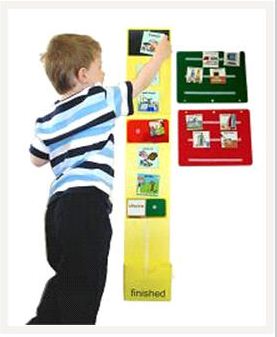Visual Supports for Children with Down Syndrome
All material Copyright © March 2009 The Down Syndrome Centre
Reprinted with the express permission of the Down Syndrome Centre as originally published on their website.
By: Marinet vanVuren
Marinet vanVuren is a South African born Speech and Language Therapist. For the past seven years she has worked with a range of Irish disability organisations including Enable Ireland, St Michael’s House and the Children’s Sunshine Home. She recently set up her own private speech and language therapy practice where she sees children of all disabilities with various speech, language and feeding difficulties.

We all benefit from visual supports. We have diaries and calendars; we watch the clock, write shopping lists and keep invitations. All children with Down Syndrome can benefit from visual supports. Visual supports are information that we can see through pictures, objects, gestures and written language. Children with Down Syndrome are strong visual learners. This means that they understand what they SEE better than what they hear. Because visual supports are concrete symbols, they assist children in processing the language, organising their thinking and remembering information. Visual supports are also an effective way to:
- Improve understanding of words, routines and situations
- Aid memory
- Give reassurance, confirmation and reduce anxiety
Examples of visual supports include:
- Visual schedules / timetables
- Choice boards
- Visually supported play
- Step-by-step directions
- Calendars
- Classroom rules
- Social stories
- Sign Language
Visual Supports for Young Children
Sometimes children with Down Syndrome understand more language than they are able to use. Visual supports are a great way to aid expressive communication.
Photographs can be taken of any object or routine and put somewhere accessible, for example
- food symbols on the fridge
- toy symbols on the toy box
Your child is then able to use the symbols to tell you what he/she wants by looking at the pictures, pointing to them or handing them over. Photographs can also be put on objects around the house to label them and help your child’s understanding, e.g. toilet, fridge, door, etc. Always remember to write the word in clear font underneath the photograph. Avoid using block capitals, underlining or italics.
Making singing fun: If you Google ‘Scope 2007 Nursery Rhymes to Sing, See and Sign’ you will find free printable resources of familiar nursery rhymes, e.g. Baa Baa black Sheep, Old MacDonald, etc. These nursery rhymes are a perfect example of the effectiveness of visual supports to encourage communication and attention. The rhymes include sign language, picture symbols and the written word. Have a look!
Please note: visual supports won’t stop your child from speaking. They are a way of adding to your child’s skills and reducing frustration.
Visual Schedules/ Timetables for Home or School
A visual timetable is a display of the sequence of events within a set period. Timetables provide a person with consistent cues about their daily routine. It helps children organise their day and know the general sequence of events. Visual timetables can be arranged in many ways. Here is a brief description from Scope* of how to make your own visual timetable.
- Make a list of the activities in the order they occur.
- Decide on the complexity of the display: will the Timetable represent daily or weekly activities?
- Decide where or how the Timetable will be displayed, for example, a wall chart or an A4 folder.
- Select photographs/pictures/symbols/words which are meaningful to your child and which match their experience of the event or activity.
- Decide on the size of each item. Items need to be large enough to be clearly seen by your child.
- Work out the number of items that your child can cope with.
- Work out what materials your display will be made of and how each item will be attached to the display, for example, blue track, self-adhesive Velcro, magnets. Items may need to be laminated to make them last longer.
- Include a way of letting your child know that an activity is finished. You can attach a ‘finished’ envelope or box at the bottom of your Timetable where your child can post the picture once the activity is completed.
*Scope (2004). InterAACtion: Strategies for Intentional and Unintentional Communicators
In conclusion: I once read a poem (unfortunately I don’t know the author) that described the use of visual supports beautifully:
- When I see … I understand
- When I hear, I forget
- In one ear, and out the next.
- But it makes more sense to me
- When there’s something I can see
- Whether I’m young, or if I’m old
- It helps to see what I am told
- A written word, a picture card
- Can simplify what might be hard.
- A visual aid describes it best
- And gives the voice and ears a rest
- From making friend to handling fear
- Showing me how makes it more clear
- There’s not much left to explain
- When a picture shows my brain
- Who or where or what you mean
- On a clear computer screen
- To recall what you heard
- A picture paints a thousand words.
Featured Organization: The Down Syndrome Centre
We thank the Down Syndrome Centre for allowing us to reprint their copyrighted article. For more information about this organization please visit The Down Syndrome Centre
PediaStaff is Hiring!
All JobsPediaStaff hires pediatric and school-based professionals nationwide for contract assignments of 2 to 12 months. We also help clinics, hospitals, schools, and home health agencies to find and hire these professionals directly. We work with Speech-Language Pathologists, Occupational and Physical Therapists, School Psychologists, and others in pediatric therapy and education.
